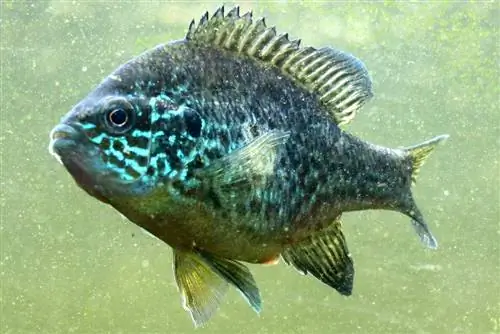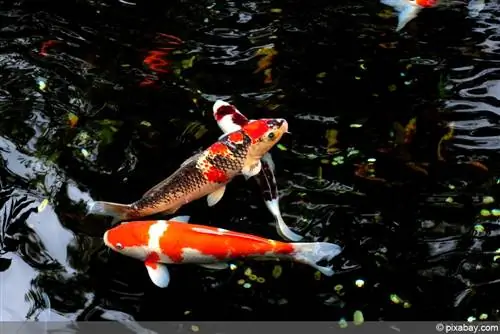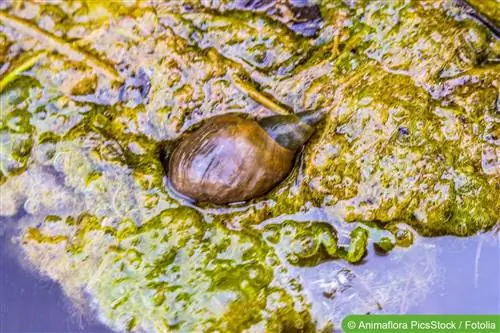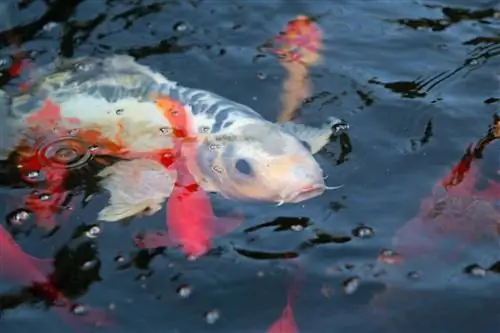- Author admin [email protected].
- Public 2023-12-17 03:39.
- Last modified 2025-06-01 06:48.
Do you dream of picturesque veil-tailed goldfish swimming around in your garden pond? Then familiarize yourself with the important criteria for correct posture. Due to their body structure, the magnificent ornamental fish require much more warmth and are less robust than classic goldfish. This guide deals with all aspects in detail, from the ideal conditions in the pond to successful breeding and successful wintering.
The perfect pond
- Premises for ideal framework conditions-
If the veil-tailed goldfish had a say, it would advocate keeping it in the garden pond. If the conditions are right here, the pretty ornamental fish feels in good hands all year round. Pond size, water quality, temperature, plant population and oxygen supply make a significant contribution to this. The following overview summarizes all the important premises for successful pond keeping of veiltail goldfish:
- Location: sunny to partially shaded, with around 30 percent of the water surface in shade
- Minimum pond size: 1000 liters
- Minimum depth: 100 to 150 centimeters
- Water quality: pH value 6.5 to 8.3, nitrate content maximum 25 mg/l, hardness 10 to 12 dH
- Temperature: 4 to 22 degrees Celsius
- Soil substrate: loose mixture of sand and fine gravel
- Equipment: Filter system and air pump for clean, oxygen-rich water
When purchasing veiltail goldfish, please remember that they are typical schooling fish. In loneliness, even under perfect conditions, there is little chance of survival. Therefore, use 4 to 5 of the ornamental fish. The more volume a pond has to offer, the larger the fish community can be. However, an excessive fish population must not occur in order to prevent illness and stress. The specific calculation of the correct balance between pond volume and number of fish is a subject of heated and controversial debate among experts. From a practical perspective, it should be noted that between 80 and 100 liters of pond water should be available for a veil-tail goldfish with a final size of 25 cm.
Aquatic plants are essential for the well-being of the fish and the biological balance in the pond. Pond plants remove excess nutrients from the water and serve as a sought-after retreat for the floating inhabitants. A balanced mix of underwater and floating plants is ideal. Cattails (Typha), water mimosa (Aeschynomene fluitans), water hyacinths (Eichhornia crassipes), spring moss (Fontinalis antipyretica) and water lilies (Nymphaea) are very popular.
Tip:
Veiltail goldfish sold at low prices in pet stores are usually not purebred Ryukin, Little Red Riding Hood, Tosakin or Veilteil. This has the advantage that they are less sensitive than highly bred veiltails and are better equipped for the requirements of keeping in a pond.
Use skillfully
- Tips for the Welcome Ceremony -
Veiltail goldfish are delicate creatures that react sensitively to sudden changes. So please take a little time to properly welcome your floating garden residents. The best time to add ornamental fish to the pond is spring. This way they have enough time to acclimatize until winter.
- Only use from a water temperature of 15 degrees Celsius
- Place the transport bag with water and fish in the water at the edge of the pond
- After 45 to 60 minutes, open the bag and pour in a few handfuls of pond water
- Reseal the bag and leave it in the water for another 30 minutes
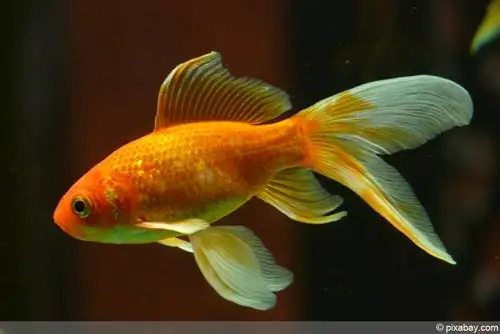
Last but not least, open the bag and release the new pond resident into the wild. This acclimation process significantly reduces stress for a veiltail goldfish. Alternatively, place the fish in a large bucket with transport water. Over the next few hours, gradually pour pond water into the container. After 2 to 3 hours the habituation process is complete and the fish moves to the pond.
Nutrition
- How to feed correctly -
Veiltail goldfish are omnivores and never seem to get full. This poses the risk that beginners will feed their pond fish too often and in too large quantities. The ornamental fish then become overweight, which significantly shortens their life expectancy. Obesity makes fish so clumsy and sedate that cats and herons have an easy time of it. Furthermore, leftover food sinks to the bottom, decomposes and significantly affects the water quality. How to feed with expertise:
- Feed only at temperatures above 10 degrees Celsius
- Eat a varied diet with a rotation of dry food, frozen food and live food
- Green leaves of lamb's lettuce or dandelions as supplementary food and distraction from pond plants
- Peas, corn and uns alted potatoes in small quantities as an easily digestible diet
- Better in 2 to 3 small portions throughout the day than the entire daily ration once
- Ideally observe one day of fasting per week
Large ponds offer fish additional food in the form of insects that fall into the water or mosquito larvae that swim on the surface. The natural food does not cover the energy needs of the lively ornamental fish, especially in summer. Dry food from the pet store is therefore an essential part of the diet. Please purchase sealed, light-tight packaged fish food in small quantities. As soon as a package is opened, the vitamins and nutrients inside decompose within a short period of time. This process makes the food unusable for your valuable ornamental fish well before the printed expiry date. Therefore, skip bulk packs, no matter how tempting the low price is.
Live food, such as white, red and black mosquito larvae, can be purchased frozen or dried all year round in well-stocked specialist retailers. There is also the option of hunting yourself during the summer months. You will find what you are looking for in standing water, rain barrels and large watering cans.
water fleas
- Premium food for young and old -
For the successful keeping of veiltail goldfish and the breeding of young fish, feeding them with water fleas is recommended. In this way, your ornamental fish receive high-quality, natural live food that is perfect as a supplement to dry food. Rich in fiber and low in nutrients, goldfish of all ages benefit from this food as overfeeding is almost impossible. Fleas that are not eaten continue to live and are only destroyed later. In contrast, dried or frozen water fleas contain hardly any vitamins and sink to the bottom of the pond as waste if they are not eaten.
Especially the water flea species Daphnia pulex can be bred easily and simply in buckets of water or ponds. The advantage of this is that you know that you are guaranteed to provide your veiltail goldfish with parasite-free food. If you feed water fleas with algae, your fish will benefit from important enzymes and bacteria, which is particularly beneficial when breeding young fish.
Tip:
A veiltail goldfish can grow up to 30 cm. The small size of juvenile fish in a pet store aquarium belies the impressive size that adult fish can reach.
Breeding
- Criteria for successful propagation -
Where veiltail goldfish feel in good hands, family planning is the top priority in spring. The spawn is usually just below the water surface, where it sticks to the pond liner or aquatic plants. After a week, silvery-black, shiny fry measuring 1 to 2 mm in size hatch. It takes up to 12 months for the offspring to identify themselves as veil-tailed goldfish. This is how long it takes for the bright colors, shapely fins and magnificent tail to develop. During this time, the dark camouflage color plays a key role in ensuring that the tiny creatures survive for so long.
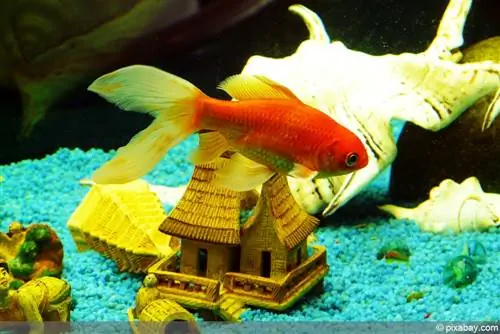
The biggest problem in breeding veiltail goldfish is cannibalism. Adult fish have no qualms about eating the young fish, even if they are their own offspring. By removing the veiltail nursery from the adult fish's reach, you solve the problem. The following options guarantee successful propagation:
- When building the pond system, create a separate, shallow, densely vegetated area for young fish
- Immediately after hatching, transfer the young fish to a separate tank
- Relocate the veiltail offspring into the house and care for them in an aquarium
Breed young fish in a tank or aquarium until they have reached a size of at least 4 cm. With this body size, you can reintroduce the offspring into the pond without the young fish falling victim to voracious conspecifics.
Wintering
- How it works -
A minimum depth of 100 to 150 cm is the most important criterion for keeping veiltail goldfish in the pond all year round. When the temperatures on the water surface drop to freezing point in winter and ice forms, the temperature at the bottom of the pond is still 4 to 5 degrees Celsius. If the fish were able to acclimatize in the water over a period of 6 months, their organisms adapted to the changed conditions without any problems.
Successful overwintering begins in autumn. Protect the pond from falling leaves with a net or net the leaves daily. In this way you can effectively prevent the dreaded foul gases, which pose the greatest danger under a winter ice cover. Also cut back perennial pond and water plants in a timely manner. Tie the stalks of ornamental grasses on the bank together with a string, as pruning for these plants is not scheduled until spring. This means that individual leaves cannot come loose and sink to the bottom of the pond. With the following measures you can guide your ornamental fish through the cold season unscathed:
- Stop feeding at temperatures below 10 degrees Celsius
- Remove the pond pump and put it away from frost
- Place an ozonizer on the bottom of the pond for a permanent oxygen supply
- Place an ice preventer on the water surface
The key to successful wintering is that the water surface does not freeze completely. With an ice preventer, a small air hole should ensure that foul gases can escape. Even a simple Styrofoam ring with a lid made of gas-permeable, buoyant material fulfills this task satisfactorily. Higher-quality devices are equipped with a low-voltage heater so that the opening remains ice-free. If the ice cover closes completely during a harsh winter, please do not punch a hole in it. The veiltail goldfish resting at the bottom of the pond are abruptly torn from their hibernation and could suffer a circulatory collapse. It's better if you gently melt a new opening in the ice cover with hot water.



